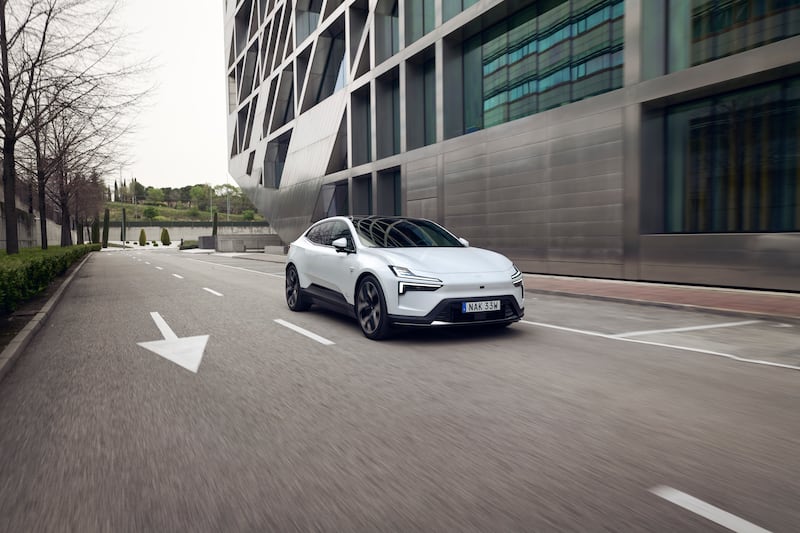It’s been a tumultuous time for this Sino-Swedish Volvo offshoot. Flying high on the back of positive reviews for its first volume production car, the Polestar 2, the product pipeline was due to deliver a showroom of new cars in a steady stream.
Unfortunately, Covid and myriad other issues delayed their arrival, so for a long time this brand was flying solo with one car.
Now it’s got two new arrivals coming to Ireland this winter, the best of which is arguably this Polestar 4.
Yes, it’s yet another heavy-set five-seater all-electric crossover. But there are enough positives about this car to let it dodge being dismissed as one more heavy lump of electrically-propelled metal.
READ MORE
Exterior styling is sleek, if not as dramatically different from the rest of the crossovers out there right now. Also, the way Polestar replaced the rear window with a metal sheet cut out in the silhouette of a window, looks a bit like a retrofit van conversion. They should have made the rear a single metal unit.

The strongest trait of the Polestar 4 is its comfort. Ride quality was a gripe we had with Polestar 2 in the past. The handling has always been sharp and agile, but the price you paid was too high on Irish roads. Executives used to being cosseted in German premium rivals found the going a little rough.
The Polestar 2 was just a little firmer than it needed to be, particularly with any Performance Packs fitted, but the Polestar 4 gets its setting right for Irish roads.
A tip for potential buyers: avoid any performance packs that stiffen the suspension and opt for the smaller wheels from the options list. On Irish roads, your passengers will thank you.
Then there’s the cabin, where the Swedish rather than the Sino influences are clearly prevalent. This is where the Scandinavians excel, as we know from every glossy home-design magazine for the last decade.
The Polestar 4 may be the mid-level model, between the 2 and the SUV-styled 3, but it’s also the car that focuses best on the back-seat occupants. Opt for the Plus Pack for €6,300 and you get electric reclining rear seats, similar to what the lucky few will have experienced on business class flights.
Given its Scandi origins, the cabin is sparse and uncluttered, though a little too dependent on that touchscreen when it comes to controls.

That’s potentially a flaw, for the touchscreen may be sleek, but to be more than form over function it’s reliant on equally elegant software. That’s been a problem for Polestar and sister brand Volvo of late – and the gremlins haven’t been fully expunged.
During our time in the test car, we encountered repeated problems with syncing our phone to the car’s touchscreen system. The big touchscreen also suffered a bout of digital meltdown at one stage.
We understand that software updates are on the way to correct these issues, but this retrofit approach to tech problems may irk many buyers. You begrudgingly accept these sorts of sell-and-fix-later tactics from smartphone and laptop providers, but it’s not what you expect from car companies.
[ Hyundai’s new €18,995 electric car is set to cause quite a stirOpens in new window ]
The lack of a rear window makes little difference after the first 50km or so; you get used to the rear-view camera screen really quickly. It can also be insightful viewing, for it offers a quality digital view of the occupants of the car behind, and you can see them on the phone, applying make-up or admiring the Polestar.
Power comes either in a rear-wheel drive 200kW (268hp) single motor or all-wheel drive dual motor 400kW (536hp) format. Both are supplied from a 100kWh ‘long-range’ battery pack.

Our test car was the single motor and due to its suspension set-up and better price, it’s the one to pick. True, the dual motor version manages 0-100km/h in just 3.8 seconds while the single motor does it in a sedate 7.1 seconds. Range claims are 620km for the single motor and 590km for the dual motors.
Far-fetched? Not really. Our single motor test car completed multiple national and motorway runs, and delivered power usage figures that would garner close to 600km on a single charge.
The Polestar 4, starting at €68,600, is up against some big-name Germans, but this premium market is warmly welcoming new brands these days, in a way that would have been unimaginable a decade ago.
It’s far from perfect, but there is a graceful elegance about this Sino-Swede that is well matched by its comfort levels on long drives. If they can get the software issues sorted, then it has enough premium traits at a competitive price to suit many executives.
Lowdown: Polestar 4 Long range Single Motor
Power: A 200kW electric motor powered by 100kW battery pack; rear-wheel drive
0-100km/h: 7.1 seconds
Electric consumption: 18.1 KW/h
Combined range (WLTP): 620km
Price: €68,600 (€76,200 for dual motor)
Our rating: 4/5
Verdict: Not without its flaws, but the best car to come from Polestar to date.















